#Oriol Balaguer
Explore tagged Tumblr posts
Text
La pastelería La Duquesita de Oriol Balaguer ha sido elegido como el Mejor Roscón de Reyes Artesano de Madrid
El maestro pastelero Paco Torreblanca junto a un seleccionado jurado de expertos han elegido en una cata a ciegas el Mejor Roscón de Reyes Artesano de Madrid y el ganador ha sido el presentado por La Duquesita de Oriol Balaguer. Otro premio que se suma a esta Confitería y Repostería como luce en el frontal de su entrada de Mejor Pastelería de Madrid 2023 otorgado por la Academia de Gastronomía de…

View On WordPress
#Barcelona#La Duquesita#Madrid#Mejor Roscón de Reyes Artesano#Mejor Roscón de Reyes Artesano de Madrid#Oriol Balaguer#Roscón de Reyes#tortell de Reis
0 notes
Photo

Chocolat du Jour Celebra 37 Anos com Coleção Especial de Oriol Balaguer
0 notes
Text
Chocolat du Jour apresenta nova coleção
Nova linha é o resultado de uma parceria com o chef patissier e chocolatier Oriol Balaguer
Nova linha é o resultado de uma parceria com o chef patissier e chocolatier Oriol Balaguer A Chocolat du Jour fez uma parceria com Oriol Balaguer – chef patissier e chocolatier ex-El Bulli – para lançar uma nova coleção. O especialista, que já parceiro de longa data da marca, batiza a linha de “Coleção Vivir es Compartir”, uma fala que costuma dizer com frequência. A nova coleção também chega…
0 notes
Photo

#food#comida#sweet#sweets#dulce#dulces#postre#dessert#torta#tortas#cake#cakes#pastel#chocolate#oriol balaguer
11 notes
·
View notes
Photo

Oriol Balaguer chocolate eggs
54 notes
·
View notes
Photo
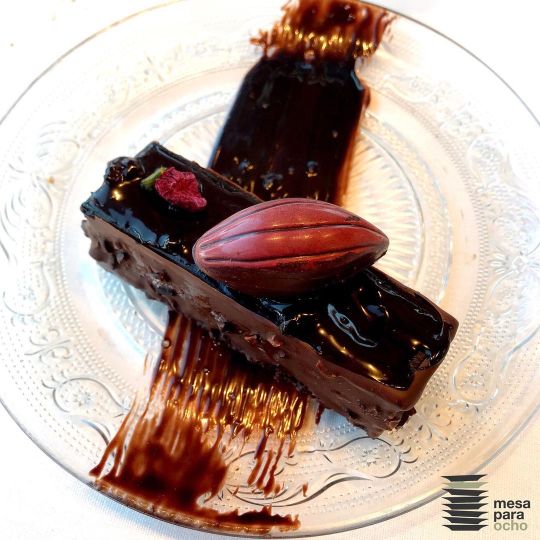
🍰 Momentazo postres de la mano de @oriolbalaguerchocolates en @brichsrestaurant 🤤 ¿Os lo podeis imaginar? ........ 👉🏼 Texturas de Chocolate de Oriol Balaguer 👉🏼 Brownie a la brasa, sal de escamas, pimienta rosa y aceite de oliva 👉🏼 Tarta de queso ........ Maridaje 🍷 con vino rosado Regina de @jgrauviticultor 🔝 ........ @marvilaplanaestrada #mesaparaocho #marvilaplanaestrada #ig_gastronomic #ig_gastronomic_cat #gastronomia #gourmetfood #gourmetexperience #oriolbalaguer #dessert #dessertlover #descobreixcatalunya #restaurantsdecatalunya #falset #foodporn #foodie #foodlover #foodphotography #foodblogger #instafood #winetasting #winelover #wineloverforever #maridaje #josepgrauviticultor (en Brichs Restaurant) https://www.instagram.com/p/CNJ93xcBS4B/?igshid=uzbvkz6npshz
#mesaparaocho#marvilaplanaestrada#ig_gastronomic#ig_gastronomic_cat#gastronomia#gourmetfood#gourmetexperience#oriolbalaguer#dessert#dessertlover#descobreixcatalunya#restaurantsdecatalunya#falset#foodporn#foodie#foodlover#foodphotography#foodblogger#instafood#winetasting#winelover#wineloverforever#maridaje#josepgrauviticultor
1 note
·
View note
Photo


Katherine of Aragon's Crown is a dessert created by the Ascaso confectionery for the publication of the book "The Thyssen on the plate". The creators took their inspiration from the portrait of the young infanta, attributed to Juan de Flandes. "The serenity and strength that is transmitted by the daughter of the Catholic Kings in this painting had an impact on us at the Ascaso confectionery from the start. Shakespeare described her as 'Queen of all the queens and a role model of femenine grace'. Through her, we also wanted to give a tribute to our land", as Sura Ascaso, responsible for the business development of the company from Huesca, explains.
The Ascaso's team moved from their bakery to the Renaissance era, while they were thinking about a dessert that could have been savored in Katherine of Aragon's times. "Having consulted various works related to cooking, like the Ruperto de Nola's (1470-1520) cookbook, we created a crown in which the roses, like the one that Katherine holds between her fingers in the painting, are key elements", Sura Ascaso explains. The "Katherine of Aragon's Crown" is a circular shaped candy made from marzipan with rose water, combined with other flavors, that were very appreciated by people of the time, such as saffron, yolk, ginger and fruit (in this case it's pear pastry). The decoration was made with yolk and natural crystallized roses: "It's a dessert that stands out due to its elegance on the plate and the combination of textures, a result of the superposition of layers. Those flavors intermingle and acquire nuances in mouth", Ascaso points out. The dessert made by confectionery from Huesca appears in the publication "The Thyssen on the plate" among other master pastry chefs, such as Paco Torreblanca, Andrea Dopico and Oriol Balaguer. (x)
The Thyssen is a museum located in Madrid, Spain.
Many thanks to @catalinaofaragon for bringing it to my attention.
#katherine of aragon#katharina of aragon#catherine of aragon#catalina de aragón#women in history#food
111 notes
·
View notes
Text
Best Artisan Chocolates in Beverly Hills
Best Artisan Chocolates in Beverly Hills
Recently, I had the opportunity to meet award winning pastry chef and talented chocolatier Kriss Harvey in his chocolate kitchen in the Arts District in Los Angeles. Named as one of America’s Top 10 Pastry Chefs, Chef Kriss was formerly the Executive Pastry Chef at The Bazaar by José Andrés at the SLS Hotel.
Looking at his arms, I noticed his tattoos told a story about his culinary journey. He…
View On WordPress
#andSons Chocolatiers#Beverly Hills#Chef Kriss#chocolates#Emily Snyder#Emmanuel Ryon#grantLove Project#José Andrés#Kriss Harvey#Nate Berkus & Associates#Oriol Balaguer#Sarah Cain & Frieze Art Fair#SLS Hotel#The Bazaar#The Dieline
0 notes
Text
El filial suma un nou triomf i s'aferra a la Superlliga
El filial s’ha imposat 3-0 al Balaguer en un partit intens, en el qual els lleidatans han mostrat caràcter defensiu, però han estat els arlequinats els dominadors del duel, sent decisius en les accions d’atac. José Enrique ha obert el marcador al minut 15, a través d’un xut de falta. A la represa, Oriol Vidal ha establert el 2-0 mitjançant un cop de cap. Finalment, a l’últim sospir, Xavi…

View On WordPress
0 notes
Photo

en Classic Line Oriol Balaguer https://www.instagram.com/p/CpNK_eQISBo/?igshid=NGJjMDIxMWI=
0 notes
Text
Interview with Artist & Pastry Chef Janice Wong
New Post has been published on https://china-underground.com/2020/10/05/interview-with-artist-pastry-chefs-janice-wong/
Interview with Artist & Pastry Chef Janice Wong
Pastry Chef Janice Wong, is the creative mind behind Singapore’s “2am: dessertbar”
In 2005, after an economics graduate from Monash University in Melbourne, Janice Wong went to Paris to study at the Le Cordon Bleu. She worked in various leading kitchens including those located in San Sebastian, Chicago, and New York. She finds her own style when in 2007 she returned to Singapore and opened her first restaurant, 2am: dessertbar, at Holland Village. Janice Wong’s unique approach to food creates beautiful interactive art. She has an eye for the finest detail and her passion for culinary art has propelled the passion to test the limits of dessert making. Chef Janice Wong’s edible art installations have been commissioned by galleries and restaurants since her creations have unique tastes that surprise the guests and clients. Janice Wong has learned from some of the world’s best chefs, including US luminaries Thomas Keller and Grant Achatz, virtuoso Spanish chocolatier Oriol Balaguer, and prodigious French pastry chef Pierre Hermé. In November 2014 she launched her eponymous sweet concept brand, Janice Wong. Chef Janice has received worldwide recognition for her cutting-edge creations.
Official site | Instagram | Janice Wong Online
How and when did you get interested in cooking and baking? How did you understand you wanted to be a Chef? What motivated you?
Well, I started in 2005. One of my main passion was to be a Dessert Chef, and that’s why I went to culinary school in Paris and started from there. I get motivated during my studies in Melbourne, Australia, where I saw a lot of fresh products. I was very inspired by the ingredients and the culinary culture. I decided that I wanted to bring that experience of mine back to Singapore.
I am always exploring new possibilities in the culinary and arts.” – Pastry Chef Janice Wong
You have studied and worked around the world in Melbourne, Paris, Tokyo, etc.. What has meant for you? You bring a fresh new taste to Singapore. Did your journey influence your tastes and creativity? What has changed for you since then?
I think for me, the main thing was to be very focused to really get a lot of skill sets and to learn as much as I could. And in every country that I was visiting, this really shaped my idea of food. I studied in Paris, and I worked there. I went to work in Australia, and then I went to work in Spain, and then in the USA. I went to study in different countries, and that allowed me to really open my mind, also to be amongst different disciplines like art, food, design, and architecture. I think these journeys have shaped me and changed me over the years to what I have become.
What do you love most about your job? What are the greatest rewards?
I truly like bringing a lot of joy to people, and I think that’s why we’re chefs because we have the ability to cook our dishes and to create art for people. And this brings a lot of joy to people.
Pastry Chef Janice Wong has released many books, filled with a mix of innovative creations, which she developed using different types of flour. She plays with ingredients, textures, flavors, and perceptions to make unconventional combinations.
You are half pastry chef and half artist. Are your dishes like canvases where you create your artwork? You made edible art installations. Can you tell us about your culinary philosophy?
My philosophy is about your world is your imagination. So it’s about however you imagine your world to be with its very colorful, black or white, very, very flavorful, joyful! Desserts tones that I use reflect it. Desserts are some of the examples that I use in my philosophy. I also balance the Perfection and Imperfection, which is the title of my book. I strive for perfection, but I also appreciate the imperfection.
Pastry Chef Janice Wong has redefined the dessert experience and pushing the boundaries between sweet and savory with carefully researched progressive dishes.
In Asia culture food is tasty and delicious, but also is visually beautiful. Since people taste also with eyes, is it an inner rule to make food more appetizing? Where do you find inspiration, and how do you balance between the taste experience and the visual aspect?
Well, food doesn’t have to be beautiful, it is just the first thing that people see. So for me, food is about the five senses, and sight is one of the senses. So that’s also one of my philosophy, it’s always about the five senses: you smell the food, taste and you feel it. And of course, you see it. So I think all of them are very important.
The cakes of Versailles high tea menu is inspired by the feature film Ottolenghi, in which Chef Janice Wong is featured
You wrote many books. You show how to use different types of flour and playing with flavors. There are ingredients or flavors that best reflect your style?
I always work with flavors that are inspiring to me or different types of cultures. So to me, it’s like when I’m in Singapore. I’m born here, and the flavors of Singapore are very pronounced, very spicy, very flavorful. When I’m in Japan for a long time, there’s much discovery of flavors and cuisine as well, because it’s very different there. So it’s very important for me to don’t be subject to one culture and one type of flavor.
Do you think there are some ingredients less used that can add a special tasty experience?
Yes! Well, I use, of course, a lot of chocolate, different types of chocolate. But I also do a relevant use of miso, mustard, and vegetables. I use quite a lot of different types of ingredients.
Janice Wong has been named Asia’s Best Pastry Chef by the prestigious San Pellegrino Asia’s 50 Best for 2013 & 2014. She also won the title of Pastry Chef of the Year from the World Gourmet Summit Awards in 2011, 2013, and 2015, including the title of Young Woman of the Year from Her World in 2012.
When you started your career as a female chef, you were one of the pioneers. What were the biggest challenges you faced at the beginning of your activity?
The biggest challenge, in the beginning, was related that in Singapore, there was not a Dessert culture. We don’t eat a lot of desserts, not like, in Japan or even in India, where they eat desserts at any time of the day. Here in Singapore, we eat more savory and sweet. This was one of the big challenges to introduce a good High Tea menu. We just recently launched our Cakes of Versailles High Tea. You can see our High Tea, on 2 AM Dessert Bar website. We have to make a nice balance of sweet and savory always, is not just like to prepare a sweet menu.
How is the situation in Asia today? What has changed since your beginning?
Well, a lot has changed. I mean, in the past, I used to just have one Dessert bar. Now we have more and more outlets and a bigger team. So we need to manage a lot more. Also, people’s expectations have changed, habits have changed, more technology, more creation, more collaboration. So much has changed in the last few years.
Her ideas are threaded by a commonality: a pursuit for perfection in imperfection, and an appreciation of imperfection in perfection, presenting an artistic, gastronomic world of flawless imperfection and flawed perfection.
Even if in western countries, people have begun to know more about Asian culinary varieties, few know about Asian dessert like mooncakes. The variation of them is huge, and you mastered the art of cooking unique styles that are almost too beautiful to eat. Are mooncakes increasing in popularity? Did western people were less familiar with them due to the connection to Mid-Autumn Festival, which is less known outside Asia?
Yeah. I would say, that culture is a very important part of certain things. Mooncake is very popular here in Singapore and also the Chinese New Year because of all the goodies. They are a very big cultural part of us and is a tradition to exchange presents and gifts. But for example, for Asian, I would say, celebrating Easter, is really difficult! I’ve tried many times, every year, to make many Easter eggs and some people just don’t give as a gift Easter eggs here in Singapore.
Can you share with us any meaningful story or significant memories from the kitchen or behind your workspace?
A nice memory I have was, of course, when I first opened the bar, when we had the Dessert bar and we made a sweet menu only. This is a really nice memory for me. When I first opened at the age of twenty-four. A very good memory is also when we did our art exhibition for The World’s 50 best Restaurant. I also did another art exhibition last year.
Photos courtesy of pastry chef Janice Wong
#ChinesePastry, #Mooncakes, #PastryChef, #Singapore
0 notes
Text
Chocolat du Jour lança coleção #fenomenal
Linha é resultado da parceria com o chef catalão Oriol Balaguer

View On WordPress
0 notes
Text
10 Chocolate Inspired Interior Designs
A few descriptive things people talk about me is my love for chocolate. Every time I went out with my loved ones, everyone knows I will order cocoa and strawberry.
With the world opening now, retail spaces are becoming cool in their decoration, cushions, textile, graphic design, space planning and interior designs. Colorful interior design is higher to achieve due to high competition and it makes me harder to think of adding chocolate to these designs. So why not turn this little distraction into a big inspiration.

Do you love chocolate as you love interior design?
The chocolate scheme is an essential part of the interior design profession over the world and across different cultures, decorative arts, and tools for centuries. Evoking warmth to accessories and space planning, the delicious addition of chocolate account expresses a sense of luxury living. From rich tanned leathers, we can have our cool cake with the limitless choice of chocolate finishes, paint, collection, fabrics, natural materials, and furniture.
Feeling inspired by my love of chocolate, let us look at the 10 chocolate-inspired interior designs that I got from a design book by Mary Mcdonald.
Ten(10) Chocolate-Inspired Interior Designs
1. CHOCOMELT CAFE
How amazing that the architects, and interior designers of this cafe created spaces and styles that respect the chocolate bar as the business uses high-end materials and follows a process that preserves its service. I must say that the interior designer created the Chocomelt’s place to evoke parts focused on chocolate treats. The professional interior designer managed to warm up the scheme of the room by the use of chromatic light. Wooden board patterns reminisced chocolate and showed decorative art while creating an appetite when you look at its interior.

2. POP SUGAR
This cute sweet shop is another to check out. Pop Sugar's sweet interior design shop has a watch, a cushion, and certain interior decoration of cool retro charm styles. People who loves retro might be in love to this place. The interior space is unique with a wavy façade and light textile which was inspired by melting chocolate. Interior designers have been very careful in painting the room in chocolate color and understand that education on balance is important.

3. 100% CHOCOLATE CAFE TOKYO
Exhibiting excitement, the Japanese cafe, designed by architects, and the best interior designers show a hospitality design with a gleaming communal, dark-wood ceiling material and mirrored walls that resembles a chocolate bar. Looking at it, the interior architecture is indeed one of a kind!

4. ORIOL BALAGUER MADRID
The atmosphere in a room with chocolate colors and collection is always calm and friendly to achieve. Would you agree with me about that? It is easy to enjoy luxury living in such interior designs, and just relax. This shop was inspired by architecture and by creating chocolate. Thus shaped as a domed light sculpture to resemble a cocoa pod. Its interior design is focused on chocolate color elements, cushions, and decorative arts.

5. La Chocolaterie De Jacques Genin Paris
A combination of brown and gold creates a bohemian atmosphere that is so rich and stylish. Stepping into this hospitality design shop and you would never guess you’d watch the home of a rebel chocolatier. Architect Guillaume Leclerc’s streamlined design and art for space planning and textile shell keep the focus and mission—on the chocolates.

6. Fleming’s Livingroom Virginia
Decorating brown with greens are always a good idea. Chocolate looks perfectly natural with green. Bright colors on chocolate create a luxury living atmosphere like living in the comfort of your house. If you want a natural vibe, pair any shade of green rugs and cushions with your brown inspiration and it will be a complete project. It’ll be a serene feel, and it will create an organic touch hospitality design kind of interior decoration. Make your base brown and sprinkle green cushions throughout the space. That simple tip can make you look like a professional interior designer, believe me!

7. Sette’s Bedroom London
Pink and brown looks good together. Actually that combination is one of my favorites. Soft shades of brown and pink colors ideas create a rustic atmosphere of a bedroom. Ask your best interior decorator to playoff brown with light walls that is within your budget. Take your dark chocolate veneer alongside lighter white stone in a bedroom and you will see that it will create a clean finish with added layers of warmth to your chic-flic room.

8. Hotel Fabrica
From its chocolate-inspired decor to choco-therapy treatments, this business does involve my favorite treat in its commercial design. The chocolate-colored wall makes a bold statement together with building codes and the use of timber adds a rich texture to the spaces and interior designs.

9. Nimvo’s Bedroom
For sophistication to a brown interior design bedrooms, hang an essential chandelier. Brown complements golds and the light. Use sparkling furniture in the bedrooms and there’s instant light-glowing style. Additional information, using light in a darker bedroom will enhance its depth and will create luxury living vibe.

10. Oasis of Chocolate
Do you know that chocolate is a good friend for the wooden details of your interior? Rich colors and natural materials embody the purest of tradition, and fine leathers will make up this luxurious interior design dining room which epitomizes elegance. You better try this in your luxury house or office.
Show your love for chocolate
You can show your love for chocolate by designing your own interior at home using the above inspirations that will definitely express your uniqueness and sweetness. You can also hire the best interior designers that will get paid commissions from you once you have your unique chocolate-inspired commercial space planning earned.
0 notes
Photo
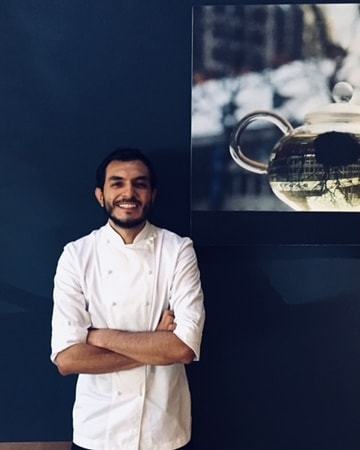
MARTEADA. A la Fonda viene a cocinar cualquiera; desde un taquero hasta un cocinero cpn premios y galardones. Lo mismo se sirve un asado norteño con tortillas de harina hechas a mano que un menú de cocina modernista. Siempre y cuando esté bien ejecutado, no hay discriminación. Nuestro invitado de hoy tiene una historia y menú interesantes: "Soy Christian Gil Calzada, tengo 27 años, soy del Distrito Federal. Soy egresado del escuela Instituto Culinario Coronado. Me enseñé de la mano del chef Mikel Alonso en el restaurnate Biko, COP16 con el chef Federico Lopez, posteriormente comencé mi carrera como Jefe de Cocina en el restaurante Raíz, dirigido por el Chef Arturo Fernandez.Durante ese tiempo tuve la oportunidad de hacer prácticas en el restaurante Alameda, por el Chef Gorka Txapartegui, en el País Vasco. Después tuve la gran oportunidad de trabajar en el restaurante Mugaritz con Dos Estrellas Michelin #4 en el mundo, de la mano del Chef Andoni Luis Aduriz. Posteriormente en Barcelona, hice prácticas con Oriol Balaguer 2015 catalogado como uno de los mejores chocolateros en el Mundo. Por último, seguí trabajando en Barcelona como Jefe de cocina en el Restaurante ETAPES con insignia Michelin. Ahora me encuentro nuevamente en México con muchas ganas de aplicar todo lo que aprendí (técnicas y procesos) con productos mexicanos; sabiendo que México tiene un gran potencial para seguir siendo una cocina que no debe de faltar en el mundo. Los platos que cocinaré son: De entrada, Ceviche de Sardinas; Sardinas marinadas en leche de tigre con chile serrano, mojo de chapulines y melón más clorofila. Va acompañado de tostadas de maíz. Segundo plato: Papada de Cerdo Laqueada; Papada de cerdo cocinada al vacío, laqueada con miel de Agave, pipián verde y zanahorias encurtidas. Postre: Tartita de mango, plátano más aguacate: Gelatina de Mango , Pasta Cigarro con trufa de Plátano tabasco, crema ligera de aguacate y aguacate cremoso . ¡Espero les guste!" Ya lo oyó. Christian comienza a servir a partir de las 8 de la noche. Sí le voy a pedir que reserve porque se atasca. Marque al 1957-7070 y separe su mesa. ¡Acá nos vemos!
2 notes
·
View notes
Photo
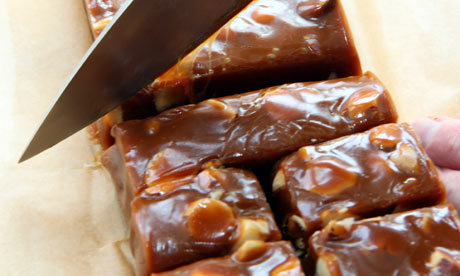
Dan Lepard's caramel masterclass
Whether it's a luxurious sauce or chewy after-dinner treat, caramel is a simple luxury. So why not make some at home
It was chocolatier Damian Allsop that gave me the heads up about combining different sugars to get a more intensely flavoured caramel, and after much tweaking in my kitchen this is the formula I've come up with. It's sufficiently variable to suit the playful minds of most Word of Mouth readers.
Ingredients
150g white sugar - regular, caster or unrefined white - plus another 150g white, soft brown, muscovado/molasses sugar 75g unsalted butter (or 50ml oil) 200ml single or double cream, clotted cream, or crème fraîche 75ml golden or corn syrup, black treacle/molasses, honey, malt or maple syrup 1/4 tsp salt
Method
First have your tin ready, and everything measured. Heat the first 150g white sugar with 25ml water in a pan until it turns a rich reddish brown (see gallery.) Then remove the pan from the heat and add the butter or oil. Add the remaining sugar, your choice of syrup, the cream and salt, return to the heat and bring to the boil, watching that it doesn't boil over. The reduce the heat slightly and simmer for about three or four minutes, or till it reaches 113C (235F) for an all-purpose caramel sauce. For a firmer caramel continue to 127C/260F for a soft set and 130C/266F for a firm set. Then remove from the heat and leave for a minute to let the bubbles subside. Swirl the pan gently to remove any remaining bubbles then pour while still hot into the tin, gently scraping it out of the saucepan with a spoon, and leave until cold.
Variations
A few of my favourite combinations (for the proportions above) with tasting notes:
Crème fraîche treacle caramels: white sugar, muscovado/molasses sugar, butter, crème fraîche, black treacle/molasses, salt.
Tasting notes: slight bitterness from the unrefined sugar plus a gentle acidity from the crème fraîche. Amazing as a sauce on ginger ice-cream, good after-dinner as a firm caramel.
Toasted brazil nut and orange caramels: all white sugar, butter, double cream, golden syrup, salt, plus, stirred in gently at the end, the finely grated zest of two oranges and 100g coarsely chopped and oven-roasted brazil nuts.
Tasting notes: rich butter flavour accentuated by the brazil nuts and lightened by the orange to stop the sweetness overpowering it. A magical sauce when poured hot over ripe bananas together with ice-cold cream. Good firm caramels for an afternoon watching a DVD.
Olive oil and black pepper caramels: white sugar, soft dark brown sugar, extra virgin olive oil, water, liquid malt extract, salt plus, stirred in with the water, 2 tsp coarsely ground black pepper and 1 tbsp cocoa.
Tasting notes: the malt and chocolate become background flavours as the olive oil and black pepper dominate. Lovely on poached pears, chocolate or black cherry ice-cream, as the chocolate in the sauce becomes more apparent. The firm caramel is perfect with a shot of espresso.
Making caramel has an intense, panicked thrill to it. It's threatening at first, but you'll soon feel a calm respect for the saucepan and its contents. Yes, molten sugar will still be spluttering and plopping with a volcanic fury, but once you replace fear with quiet respect then the measured steps involved in making caramel become much more controllable and subdued.
So, scary, yes. Difficult, no. Time-consuming, no. Expensive, heck no. Caramel is one of the cheapest treats you can concoct in the kitchen, and one of the simple luxuries that's resurfaced at top restaurant menus. Low cost plus high satisfaction equals chef heaven. In the 1980s caramel on a menu was, from what I remember, a simple, dark and bittersweet affair. It might have been caramel ice-cream, perhaps using a Freddy Giradet recipe; the crunch of spun sugar over a peach melba à la Marco; the brutish syrup bathing scorched apples in a classic tarte tatin at Chez Panisse or Alastair Little, or perhaps the brown underbelly of a crème caramel or the delicate upper crust on a brûlée. Beyond that, caramel was viewed by many chefs as just sweetshop stuff, lacking the balls needed for grand dining's testosterone-fuelled kitchens. Well, that's in the past.
Making caramel at home today puts you in good company. Christophe Michalak, the head pastry honcho from the Hotel Plaza Athénée in Paris, who's spending part of his summer at the Dorchester attempting to raise their afternoon tea patisserie from perfect to sublime, is a caramel convert. I know my choux from my shoes so I can tell you that his religieuse caramel beurre de sel - trading as crisp choux pastry filled with caramel praline and untold calories - is a heavenly wonder you won't see at a church fête. There are subtle techniques that Christophe and other innovative pastry chefs use that can simply and quickly transform what we make at home.
1. Start with the right kit
For anything beyond a simple burnt sugar caramel for, say, a crème caramel, you need to buy a sugar thermometer. Repeat that until you whisper it in your sleep. Don't muck about doing set tests with teaspoons and murky water. Just spend seven odd quid and buy one. If you think that's too expensive, buy one and remember to leave it to someone in your will. It's the quickest, easiest and safest way to make great caramel. But make sure it's heatproof, and that the numbers won't boil off. David Lebovitz, the online guru for all things sweet and an expert on caramel making, told me that you can't solely rely on the manufacturer's label. "I bought a top-end candy thermometer and it melted. It was plastic coated and they said it was silicone. Professional, 25 euros, and it melted." Go for something metal and glass and decidedly old-fashioned.
Also, make sure you have a saucepan with a heavy thick base. I useMeyer Anolon saucepans. That's not a plug: I bought them in the sale and am very happy with them. Try and get a pan that conducts heat evenly; hard anodised aluminium works better than stainless steel.
My advice: as well as the heatproof thermometer and heavy-based saucepan, you'll need kitchen scales and a wooden spoon.
2. Be careful and organised, and stay relaxed
My partner David's mother Rosina was a fairly hardcore marmalade maker well into her 80s, and her frail manoeuvring of her scalding hot saucepan of boiling sugar syrup would panic me. But the pleasure she took making it outweighed any fear in her mind. Caramel involves a much smaller pan of sugar and much less danger than deep frying or marmalade making, but danger is relative and there are steps you should take to stay safe. Clear away any distractions. Don't stick your fingers in, even though it looks inviting. Remove the pan from the heat when adding new ingredients, expect fats and liquids to bubble and spit furiously when added, and stand back till the bubbling subsides. Should a small drop of boiling sugar hit your skin, hold the area immediately under cold running water for a few minutes.
But don't let the fear put you off. I asked Dorie Greenspan about the wall of fear surrounding caramel. "I was petrified of making caramel", she told me, "and I don't think I started making caramel until I started working with Pierre Hermé. Watching him make it I realised that it's much easier than so many of the recipes make it appear. You learn to make it by look and smell, and that's not something a recipe can explain."
My advice: if your caramel is going into a tin or tray, get that set up first and lay a damp cloth underneath it so it doesn't wiggle about when you pour. Have the ingredients measured so you can add them when the time is just right. And stay calm.
3. Start with white sugar
I asked Oriol Balaguer, the Barcelona-based master of chocolate and sugar, about the sugar question, as now even small supermarkets stock a bewildering array of sugars, syrups and substitutes. "I practically always use white sugar (sucrose) to give a pure sweet taste to caramel", says Balaguer, "and though you can and I do use other sugars, syrups or derivatives like fructose and dextrose, I find I almost always prefer sucrose." At first, using white sugar will make gauging the colour of the caramel much easier. But with practice you should be able to try unrefined ('golden') sugar. Damian Allsop, one the most innovative of the new artisan confectioners in the UK, is a fan of unrefined sugar. "Unrefined sugar is a big thing in my kitchen. It has more flavour, and a flavour that's more complex. So you can do what you do with a classical caramel but just experiment with different combinations to get different intensities. I like to substitute a third of the light sugar in a recipe with muscovado for a powerful flavour."
My advice: if you're making a caramel for a tarte tatin or crème caramel, use all refined sugar. If you're making soft caramels or sauces try replacing half the refined white sugar in the recipe with brown sugar (any sort), but only caramelize the white sugar. Then add the remaining brown sugar when you add the butter and cream.
4. Burnt is closer to what you want
We've put together a guide showing the different stages sugar goes through on its trip through caramel country, from white to black. Talking to different chefs and experts, the general consensus seems to be that the darker the caramel, the better. Once you put the sugar in the pan, with a dash of water to make life easier, the sugar will go through different visible stages. First it forms a white syrup, and then a clear syrup that occasionally has a frost-white crust on the top. It then begins to turn a golden caramel at the edges; swirling the pan as it cooks further will take it to a uniform golden caramel. From this point on it will turn a rich golden caramel, a dark reddish caramel, a darker brown caramel with wisps of smoke, and finally it's burnt black. For chefs like David Lebovitz, it's that dark reddish caramel that you should aim for. "When I worked at Chez Panisse, I was the one in the pastry department that always took it to the edge," says Lebovitz, "Often cookbooks say to cook the sugar until it's smoking, but for me that's not far enough."
For Christophe Michalak, golden is divine. "The caramel from Brittany is for me the best one as they don't cook the sugar too much," he says. "It looks like caramel but it's very soft." But for Balaguer the spellbinding power is in choosing how dark to go. "Sugar has different points of caramelisation, each with a distinctive flavour", he explains, "and combining these opens a world of magical possibilities. You need to decide how you want to use it and what you'll combine it with, and then decide what kind of caramel is best." Apples suit a dark caramel, but dark fruit like fresh figs are best paired with a golden caramel. That's not to say there are strict rules, but strong flavours generally suit a medium caramel, and vice versa.
My advice: if you feel your guests have a sophisticated tastes aim to take the caramel to a reddish to dark brown. If you think they're going to be a bit timid, aim for something between rich golden to dark reddish caramel.
5. The cooking temperature is …
My advice: I don't know. I can give you a guide, but the consistency your caramel sets to will depend on the ingredients. More fat will keep the caramel from turning too hard, but might also make it too soft to cut. Less fat might make the caramel brittle and hard. So if your mixture is rich with cream and butter, cook the caramel to a higher temperature for a firmer set. If it's quite lean, cook it to a lower temperature.
Now the next tip is an odd one. I prefer to measure the temperature in Fahrenheit rather Celsius, as it's easier to read the gradual increase in temperature on my old-fashioned thermometer. No difference on a digital thermometer, but on a glass one Fahrenheit is easier.
For a soft eating caramel, take the temperature to somewhere between 260F to 265F, depending on your recipe.
6. Practice, practice, practice
Don't feel trapped by recipes. You can practice with very simple ingredients and still make something lovely, like the caramel apples in the gallery. I had a few dessert apples in the fruit bowl that had to be used. So I peeled, cored and quartered them, then simply put 75g sugar in a frying pan with a dash of water and heated that continuously till it turned a golden caramel. Then I added 25g butter and the apples, and cooked them gently with about 50ml water until they were almost tender, adding a dribble more water every so often so they stayed moist. At first bits of hard toffee formed but that soon dissolved in the juices from the apples. I had a little brandy in the cupboard so I added a dash, say 25ml, and let it simmer for a minute more. This gave a beautiful, simple caramel butter sauce around tender pieces of apple, and the result looked rich and luxurious even with scoops of not-so-glamorous supermarket ice-cream. You want cheap chic? Caramel apples are it in my book.
So there it is. You should have enough here to whip yourself into a caramel frenzy. Do post any questions and I'll try to answer them, or point you to a site that helps. David Lebovitz's caramel blog is an excellent resource you must check out, but do let us know if you have any sites or tips to help.
0 notes
Text
Carles Abellán | La Barra | Barcelone
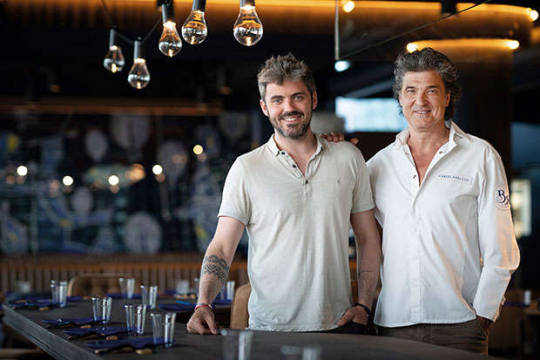
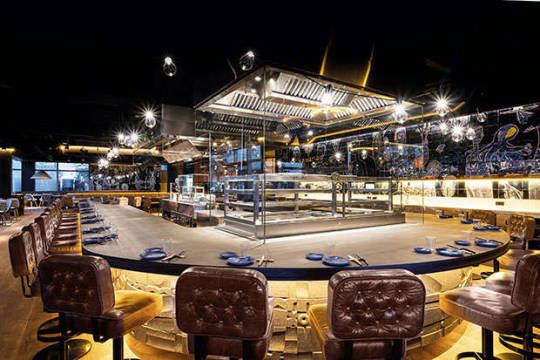
© La Barra, Carles Abellán
Situé sur le Passeig Joan de Borbó, un des lieux très fréquentés de Barcelone, dans l’enceinte de l’hôtel W Barcelona, le restaurant La Barra de Carles Abellán, est une table vraiment atypique. Carles Abellán, disciple de Ferran Adria, est un chef talentueux à la cuisine créative, audacieuse, enjouée, généreuse...
Situé au niveau E de l’hôtel W Barcelona, le restaurant La Barra de Carles Abellán est une des tables de références de Barcelone. Après avoir été formé à Barcelona School of Hospitality dès l’âge de 21 ans, en même temps que Sergi Arola et José Andrés entre autres, Carles rejoint un groupe de chefs aux idées très avant-gardistes - «Joves Cuiners» - parmi lesquels se trouvait Ferran Adrià.
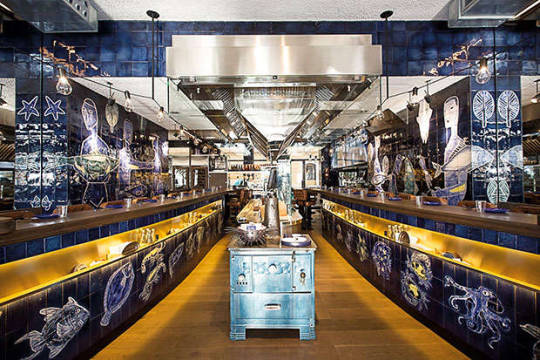
© La Barra, Carles Abellán « Ayant entendu dire qu'il était à moitié fou, je lui ai demandé de venir à El Bulli pour voir ça ... et il m’a dit OUI! Pendant la Semaine Sainte en 1987, j'étais déjà à Cala Montjoi avec lui. J’ai tout de suite été séduit !» La suite est de l’histoire. Ferran et Juli Soler (associé de Ferran) lui proposent d’être chef et directeur du restaurant Talaia Mar, qui deviendra une véritable légende. « Nous y avons développé la cuisine El Bulli au format tapas. Avec moi se trouvaient Sergi Arola et Oriol Balaguer. Avec Ferran nous avons eu la fièvre créatrice pendant deux ans et avons développé ensemble divers restaurants jusqu’au jour où j’ai créé Comerç 24 à Barcelone en 2001.»
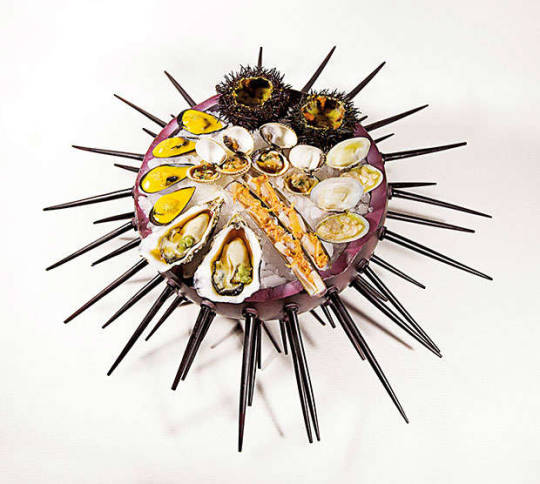
© La Barra, Carles Abellán A Comerç 24, restaurant atypique, Carles propose une cuisine miniature, des tapas «d’auteur», quelque chose qui n’existait pas dans une ambiance très contemporaine, très new-yorkaise. Par la suite, Carles Abellán ouvre différents restaurants: les Tapas 24, Ena et finalement Bravo qui deviendra La Barra dans l’enceinte du W Barcelona (hôtel surnommé La Vela par les locaux). « Pour anecdote: un soir Mick Jagger est arrivé à Comerç 24... Oui, un soir il est venu dîner, à la dernière minute et sans réserver… Ce fut quelque chose de brutal, ce fut le Le branle-bas de combat. »

Tomàs et Carles Abellán © La Barra, Carles Abellán Entouré de son fils Tomàs, Carles signe une carte de belles saveurs inspirée par la Méditerranée. À La Barra, poissons, fruits de mer et tapas créatifs sont vraiment les stars dans les assiettes. Avec 100 m2, stylisés par le célèbre architecte Lázaro Rosa Violán, deux immenses «barras de cocina» (sorte de comptoirs) font face à une cuisine ouverte avec Robata (grill japonais) et grill basque... À la carte du moment on se régalera des «Tapitas del puerto»: aubergine en marinade andalouse; carpaccio de crevettes à l'ail ou coques galiciennes au citron... entre autres, à faire suivre par les suggestions «Sobre las barcas»: couteau galicien grillé avec ponzu; crevette rouge xxl de barceloneta; suquet de cabracho de Cala Montjoi entre autres. On aimera aussi découvrir la «Frita de Langosta al estilo de Formentera», un homard vraiment surpenant et délicieux.
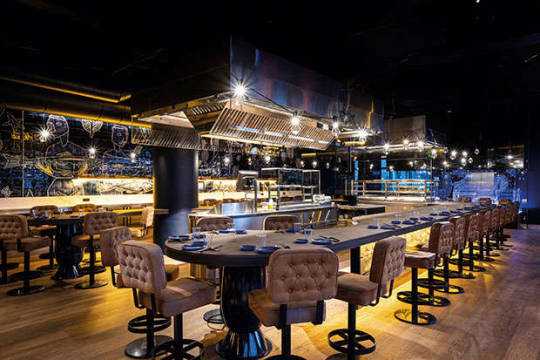
© La Barra, Carles Abellán Côté dessert, on découvre un étonnant « brie-cake à la truffe melanosporum» ou encore d’excellentes fraises à la crème: « Fresas del Maresme con nata ». Fraîcheur des produits, cuissons parfaites, pleines saveurs et créativité phénoménale sont les maître-mots pour décrire la cuisine de Carles Abellán. Côté vins, la carte joue l’originalité et la pertinence... Les harmonies mets et vins sont bien choisies. Une table incontournable à Barcelone. Carles Abellán | La Barra | Barcelone La Barra Hotel W Barcelona, Planta E, C/ Rosa dels Vents, 1. 08039 Barcelone, Espagne +34 93 295 26 36 Internet: www.carlesabellan.com Read the full article
#CarlesAbellàn#étoiléMichelin#ferranadria#gastronomie#gastronomiebarcelone#LaBarra#LaBarraBarcelona#RestaurantsBarcelone#TapasBarcelone#TomàsAbellán#WBarcelona
0 notes